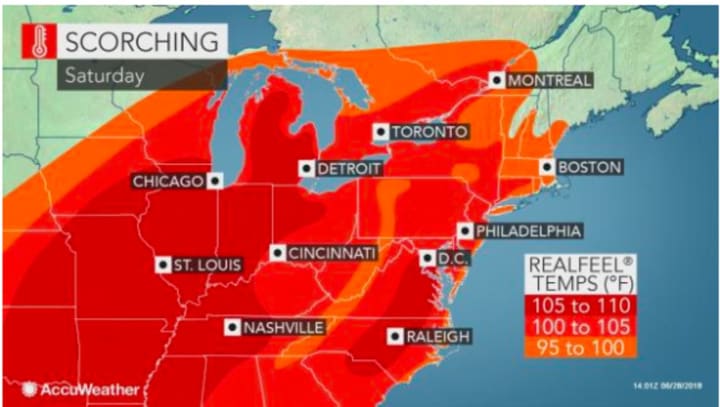With heat indices - the combination of actual temperature and humidity - expected to hover around the 100-degree mark over the weekend, the National Weather Service has issued a Heat Advisory that starts at noon Saturday.
The advisory will be in effect until 9 p.m. on Saturday, though the National Weather Service noted that heat index values may be even higher on Sunday. The highest heat indices will be in the mid to late afternoon.
A heat advisory is issued when the combination of heat and humidity is expected to make it feel like 95 to 99 degrees for two or more consecutive days, or 100 to 104 degrees for any length of time.
"The heat index, also known as the apparent temperature, is what the temperature feels like to the human body when relative humidity is combined with the air temperature," according to the National Weather Service. "This has important considerations for the human body's comfort."
The extreme heat can cause illness and death among at-risk population who cannot stay cool. The heat and humidity may cause heat stress during outdoor exertion or extended exposure.
“With a stretch of extreme heat and humidity ahead of us, I urge residents and visitors to take the necessary precautions to keep themselves and their families safe," New York Gov. Andrew Cuomo said earlier this week. "I encourage all New Yorkers to take advantage of state cooling stations, pools and water bodies across the Empire State and to be mindful of air quality and other health risk factors to ensure a safe, enjoyable holiday weekend.”
According to the New York State Department of Health, research, funded by NASA, showed that emergency department visits and hospital admissions from heat increase significantly on days when the heat index reaches 95 degrees or higher. The risk of heat stress, dehydration, renal illness, cardiovascular illness and death increases for up to four days after a heatwave, which is defined as three or more consecutive days with temperatures topping 90 degrees.
Officials have released a series of tips to help New Yorkers beat the heat and avoid becoming a victim of Mother Nature:
- Slow down on strenuous activity and exercise, especially during the sun's peak hours of 11 a.m. to 4 p.m.;
- Exercise should be done in the early morning between 4 a.m. and 7 a.m.;
- Eat less protein and more fruits and vegetables. Protein produces and increases metabolic heat, which causes water loss. Eat small meals, but eat more often. Do not eat salty foods;
- Drink at least two to four glasses of water per hour during extreme heat, even if you do not feel thirsty. Avoid beverages containing alcohol or caffeine;
- If possible, stay out of the sun and stay in air conditioning. The sun heats the inner core of your body, resulting in dehydration. If air conditioning is not available, stay on the lowest floor, out of the sunshine, or go to a public building with air conditioning;
- If you must go outdoors, wear sunscreen with a high sun protector factor rating (at least SPF 15) and a hat to protect your face and head. When outdoors, wear loose-fitting, lightweight and light-colored clothing. Cover as much skin as possible to avoid sunburn and over-warming effects of sunlight on your body;
- Do not leave children, pets or those who require special care in a parked car or vehicle during periods of intense summer heat. Temperatures inside a closed vehicle can reach over 140 degrees Fahrenheit quickly. Exposure to such high temperatures can kill within a matter of minutes;
- Make sure there is enough food and water for pets.
Click here to follow Daily Voice Briarcliff and receive free news updates.


